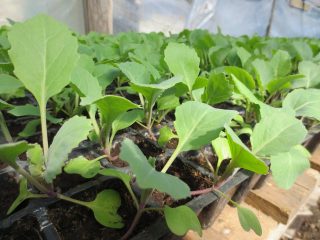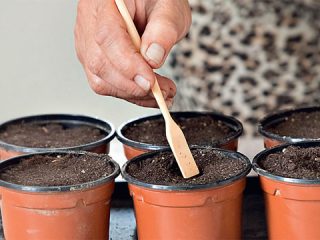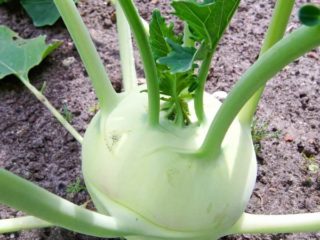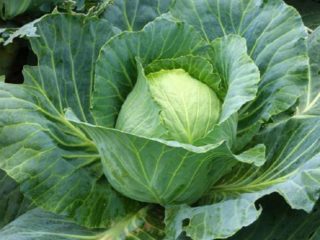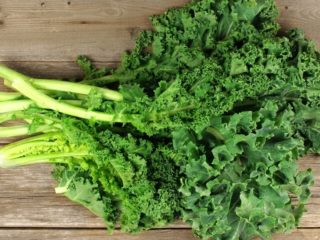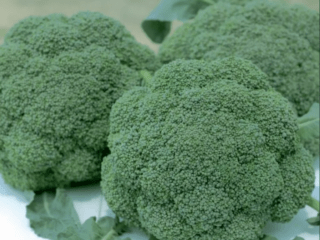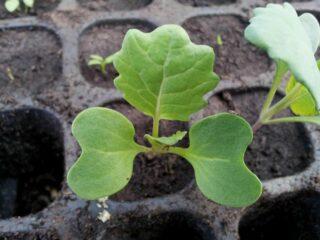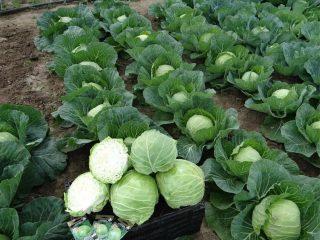Content
Red cabbage is valued for its high content of anthocyanins, which determines the color of its leaves, as well as vitamins and minerals. Therefore, many gardeners grow this variety of vegetable on their plot. In addition, planting red cabbage and further caring for it do not cause any particular difficulties. But in order to get a good vegetable harvest, you still need to take into account the basic requirements of the crop, so you need to familiarize yourself with them first.
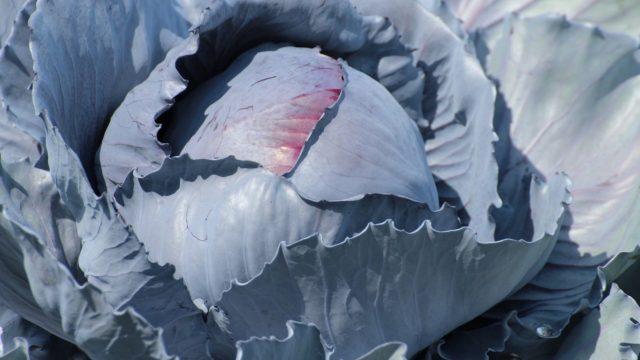
Red cabbage has increased resistance to pests and diseases
Timing for planting red cabbage in open ground
This vegetable belongs to the cold-resistant category. Therefore, red cabbage can be planted in open ground early, as soon as the ground warms up to a depth of 5 cm. In the southern regions of the country, sowing is possible at the end of March, at the beginning of April, and in the central and northern regions - at the end of the second month of spring.
However, to choose the optimal planting date, you also need to pay attention to the duration of ripening of the variety. Early and middle types of crops need to be planted early, which will allow you to get a harvest at the end of summer. It is not recommended to rush into planting late types of red cabbage, since their heads need to be cut off in the fall. This guarantees good ripening and long shelf life of the crop.
Growing red cabbage in open ground
Growing red cabbage will not cause any particular difficulties if you choose the right place for the vegetable on your plot, prepare the bed and plant it. It is not recommended to ignore these rules, since the volume of the future harvest directly depends on them.
Site selection
A sunny, open area is suitable for planting red cabbage. It is important that the soil on it is fertile, retains moisture well and has a neutral acidity level. It will not be possible to grow a good harvest of red cabbage in a shaded place, since in this case the crop begins to get sick, grows poorly and forms small heads.
This vegetable should not be planted after cruciferous plants. The best predecessors for red cabbage are legumes, potatoes, and cucumbers.
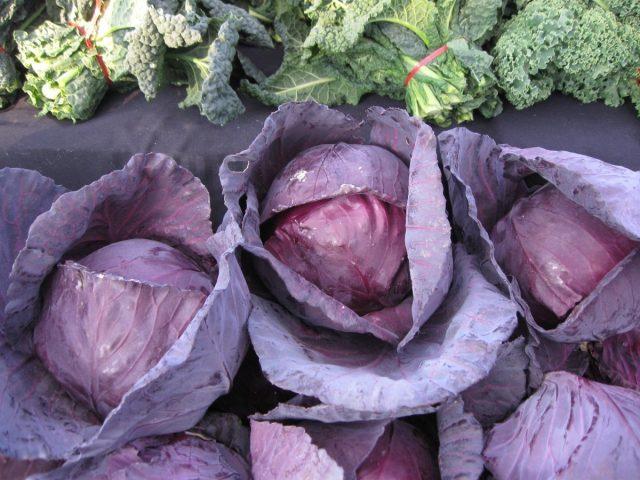
It is possible to plant red cabbage in its original place only after 3-4 years.
Soil preparation
You need to start preparing the site for sowing vegetables at least two weeks in advance. To do this, you need to dig it up and add wood ash at the rate of 200 g per 1 sq. m. m.Then the area must be carefully leveled to eliminate the possibility of the formation of depressions and hills.
In case of increased acidity of the soil, preparation before planting should be carried out in the fall. When digging an area, it is recommended to add 200 g of dolomite flour per 1 square meter. m, as well as humus at the rate of 10 kg for the same area size.
Planting scheme for red cabbage
This vegetable requires sufficient free space in the garden. Therefore, in order to successfully grow red cabbage and get a good harvest in the end, you need to strictly adhere to the recommended planting scheme. For early varieties 70 by 35 cm, medium - 80 by 50 cm, and for late varieties - 90 by 70 cm.
The vegetable should be planted in holes to a depth of 2-3 cm. Place 2-3 seeds in each hole, and when sprouts appear, leave one of the strongest ones. After planting, it is recommended to cover the bed with agrofibre. However, in case of increased sun activity, the cover must be removed during the day, since at the initial stage of vegetable growth this negatively affects its development.
Caring for red cabbage in open ground
To get a good harvest, it is important not only to plant red cabbage correctly, but also to provide proper care for it in the open ground. Therefore, you should study the features of agricultural technology in order to avoid serious mistakes.
Watering
This vegetable does not tolerate a lack of moisture. Therefore, it needs to be watered regularly in the absence of rain for a long time. At the initial stage of development and during the formation of heads of cabbage. During this period, moisturizing is recommended 2-3 times a week.The rest of the time, watering can be reduced to once every seven days. Two weeks before harvesting, it is recommended to completely stop moistening the beds, since excess moisture in the soil can lead to cracking of the heads of cabbage.
To water red cabbage, you must use settled, or better yet, rainwater at a temperature of +15-20 °C. You can apply it at the root, and during hot periods, additionally irrigate the cabbage over the leaves using sprinkling.
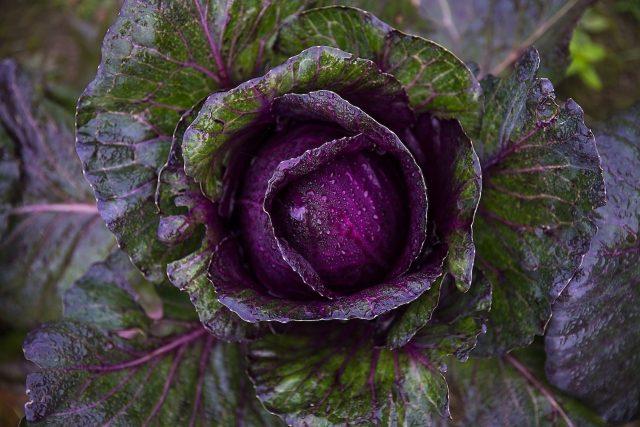
It is recommended to water red cabbage in the evening.
Hilling and loosening
After each moistening, the soil in the garden bed must be loosened. This will maintain air access to the root system of the seedlings and prevent the formation of a crust on the soil surface. It is also important to promptly remove weeds at the initial stage of seedling development. Loosening the soil and weeding can be stopped after the leaves of the vegetable have closed.
As red cabbage grows, it needs to be hilled periodically. This procedure increases productivity and promotes the development of a powerful root system. It is recommended to hill up early and middle varieties of red cabbage twice per season, and late varieties at least three times.
Top dressing
This vegetable needs sufficient nutrients. Therefore, it is recommended to fertilize red cabbage twice or thrice per season. The first time fertilizing is necessary at the stage of appearance of 3-4 true leaves. During this period, the crop needs increased nitrogen content. Therefore, it is recommended to use organic matter to feed it, namely chicken manure 1:15 or mullein 1:10.
It is necessary to fertilize red cabbage for the second time during the season during the formation of heads of cabbage.At this time, to feed the crop you need to use 30 g of superphosphate and 15 g of potassium sulfate per bucket of water. It is recommended to fertilize only late varieties of crops for the third time in order to increase their shelf life. To do this, you can use wood ash extract. To get it, you need to pour 200 g of the component into 1 liter of hot water and leave for a day. And after the waiting period, the volume of liquid must be increased to 10 liters.
Treatment against diseases and pests
If the rules of care are violated and the growing conditions are inappropriate, the immunity of red cabbage is reduced. In this case, the vegetable may be affected by cabbage flea beetles, aphids, thrips, and moths. Therefore, when the first signs of damage appear, cabbage should be treated with insecticides such as Twix, Calypso, Aktara, Iskra. If repeated treatment is necessary, the preparations must be alternated to avoid pest addiction. The vegetable is also susceptible to attack by slugs. To protect seedlings from them, it is recommended to sprinkle wood ash at their base, and in case of mass distribution, use toxic granules based on metaldehyde.
Diseases can also cause damage to red cabbage plantings. The most common of them are gray rot, clubroot and black spot. Therefore, in order to prevent damage, it is recommended to follow the rules of crop rotation, care, and also carry out preventive spraying with fungicides.
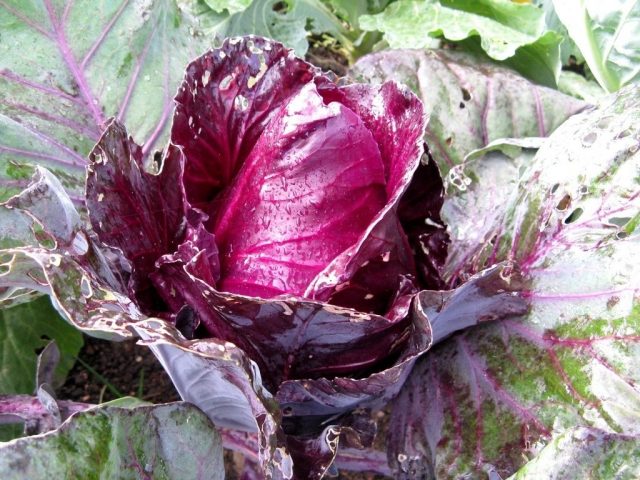
Regular inspection of plants allows you to respond to warning signs in a timely manner.
Harvesting and storage
Harvesting is recommended in dry, sunny weather.Early varieties ripen in August, and late varieties at the end of September. It is recommended to collect fruits intended for long-term storage when the temperature during the day is +5 °C and at night is about 0 °C.
When cutting the heads, you need to leave no more than two covering leaves and a stalk about 2-3 cm long. It is recommended to store the crop at a temperature of +2-4 ° C and an air humidity of 85%. The harvest must be placed on a wooden floor with the heads facing up. During storage, it is important to periodically sort through the fruits and clean them of rotten leaves.
Possible problems
Red cabbage belongs to the category of undemanding vegetable crops. However, sometimes novice gardeners complain that it is not always possible to get a good harvest. Therefore, you need to know what problems may arise when growing vegetables.
Among them:
- Heads of cabbage are not formed. This happens when the vegetable is planted late, as well as as a result of insufficient lighting of the seedlings.
- Limp leaves even with timely watering. This sign indicates damage to the root system. The most common cause is clubroot. To prevent this, you need to observe crop rotation and fertilize in a timely manner.
- Cracking of heads of cabbage. The problem arises when the soil is waterlogged and the harvest is delayed.
Conclusion
Planting red cabbage, as well as further caring for the vegetable, does not require complex actions. It is enough just to adhere to the recommended sowing dates and standard rules of agricultural technology. This will allow you to get a good harvest of the crop and ensure its long-term preservation.
